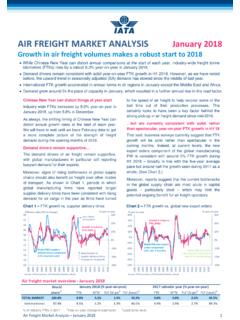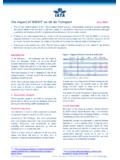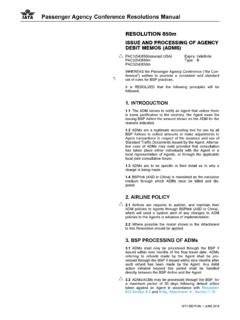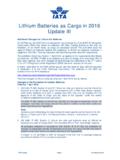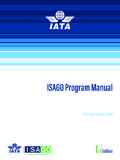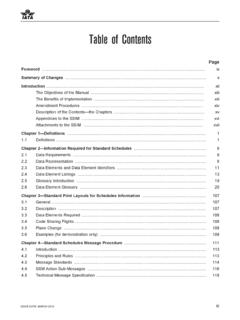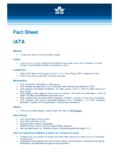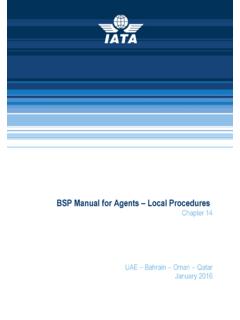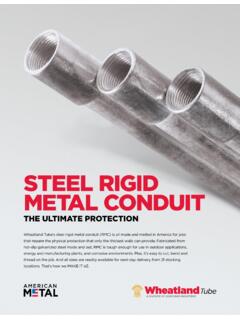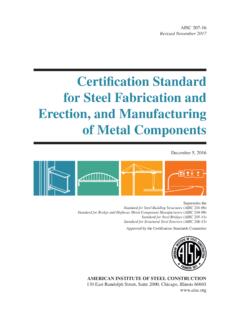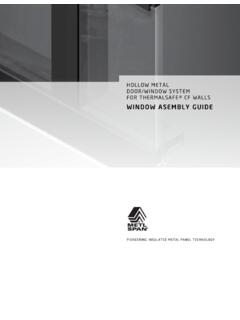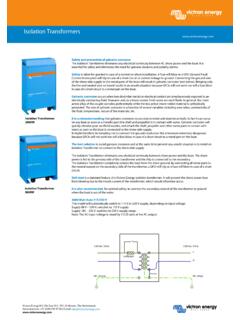Transcription of Transport of Lithium Metal and Lithium Ion Batteries
1 OSS/Cargo Page 1 19/11/2021 2022 Lithium Battery Guidance Document Transport of Lithium Metal and Lithium Ion Batteries Revised for the 2022 Regulations Introduction This document is based on the provisions set out in the 2021-2022 Edition of the ICAO Technical Instructions for the Safe Transport of Dangerous Goods by Air (Technical Instructions) and the 63rd Edition of the IATA Dangerous Goods Regulations (DGR). The provisions of the DGR with respect to Lithium Batteries may also be found in the IATA Lithium Battery Shipping Regulations (LBSR) 9th Edition. In addition to the content from the DGR, the LBSR also has additional classification flowcharts and detailed packing and documentation examples for Lithium Batteries . Information on the DGR and LBSR can be found here: The purpose of this document is to provide guidance for complying with provisions applicable to the Transport by air of Lithium Batteries as set out in the DGR.
2 Specifically, the document provides information on: Definitions; Classification (including classification flowcharts); Prohibitions; Restrictions; Frequently Asked Questions Additional Information Abbreviations, Acronyms, Symbols IATA Lithium Battery Guidance Document 2022 OSS/Cargo Page 2 19/11/2021 Definitions Lithium Battery The term Lithium battery refers to a family of Batteries with different chemistries, comprising many types of cathodes and electrolytes. For the purposes of the DGR they are separated into: Lithium Metal Batteries . Are generally primary (non-rechargeable) Batteries that have Lithium Metal or Lithium compounds as an anode. Also included within Lithium Metal are Lithium alloy Batteries . Lithium Metal Batteries are generally used to power devices such as watches, calculators, cameras, temperature data loggers, car key fobs and defibrillators. Note: Lithium Metal Batteries packed by themselves (not contained in or packed with equipment) (Packing Instruction 968) are forbidden for Transport as cargo on passenger aircraft).
3 In accordance with Special Provision A201, Lithium Metal cells or Batteries that meet the specified quantity limits may be shipped on a passenger aircraft under an approval issued by the authority of the State of Origin, State of Destination and State of the Operator. Or in the case of urgent medical need, one consignment of Lithium Batteries may be transported as Class 9 (UN 3090) on passenger aircraft with the prior approval of the authority of the State of Origin and with the approval of the operator, see Special Provision A201. All other Lithium Metal cells and Batteries can only be shipped on a passenger aircraft under exemption issued by all States concerned. Lithium -ion Batteries (sometimes abbreviated Li-ion Batteries ) are a secondary (rechargeable) battery where the Lithium is only present in an ionic form in the electrolyte. Also included within the category of Lithium -ion Batteries are Lithium polymer Batteries .
4 Lithium -ion Batteries are generally used to power devices such as mobile telephones, laptop computers, tablets, power tools and e-bikes. Note: Lithium ion Batteries packed by themselves (Packing Instruction 965) (not contained in or packed with equipment): (a) must be shipped at a state of charge (SoC) not exceeding 30% of their rated capacity. Cells and/or Batteries at a SoC of greater than 30% may only be shipped with the approval of the State IATA Lithium Battery Guidance Document 2022 OSS/Cargo Page 3 19/11/2021 of Origin and the State of the Operator under the written conditions established by those authorities, see Special Provision A331; and (b) in accordance with Special Provision A201, Lithium ion cells or Batteries that meet the specified quantity limits may be shipped as cargo on a passenger aircraft under an approval issued by the authority of the State of Origin, State of Destination and State of the Operator.
5 Or in the case of urgent medical need, one consignment of Lithium Batteries may be transported as Class 9 (UN 3480) on passenger aircraft with the prior approval of the authority of the State of Origin and with the approval of the operator, see Special Provision A201. All other Lithium ion cells and Batteries can only be shipped as cargo on a passenger aircraft under exemption issued by all States concerned. Aggregate Lithium content means the sum of the grams of Lithium content contained by the cells comprising a battery. The technical definition of a battery and cell, as indicated in the UN Manual of Tests and Criteria, is as follows: Battery means two or more cells or Batteries which are electrically connected together and fitted with devices necessary for use, for example, case, terminals, marking and protective devices. Units which have two or more cells that are commonly referred to as "battery packs", "modules" or "battery assemblies" having the primary function of providing a source of power to another piece of equipment are for the purposes of the UN Model Regulations and this guidance document treated as Batteries .
6 See definitions for cell and single cell battery . (See also Power Banks ) Button cell or battery means a round small cell or battery when the overall height is less than the diameter. Cell means a single encased electrochemical unit (one positive and one negative electrode) which exhibits a voltage differential across its two terminals. Under the UN Model Regulations, UN Manual of Tests and Criteria and this guidance, to the extent the encased electrochemical unit meets the definition of cell herein, it is a cell , not a battery , regardless of whether the unit is termed a battery or a single cell battery outside of the UN Model Regulations, the UN Manual of Tests and Criteria and this guidance. Consignment, one or more packages of dangerous goods accepted by an operator (airline) from one shipper at one time and at one address, receipted for in one lot and moving to one consignee at one destination address.
7 Net quantity, either: (a) the weight or volume of the dangerous goods contained in a package excluding the weight or volume of any packaging material; or (b) the weight of an unpackaged article of dangerous goods ( UN 3166). For the purposes of this definition dangerous goods means the substance or article as described by the proper shipping name shown in Table , for Fire extinguishers , the net quantity is the weight of the fire extinguisher. For articles packed with equipment or contained in equipment, the net quantity is the net weight of the article, for Lithium ion Batteries contained in equipment , the net quantity is the net weight of the Lithium ion Batteries in the package. Overpack means an enclosure used by a single shipper to contain one or more packages and to form one handling unit for convenience of handling and stowage. Dangerous goods packages contained in the overpack must be properly packed, marked, labelled and in proper condition as required by the IATA Dangerous Goods Regulations.
8 The overpack must not contain packages enclosing different substances which might react dangerously with each other or packages of dangerous goods which require segregation according to Table In addition, packages containing UN 3090, Lithium Metal Batteries prepared in IATA Lithium Battery Guidance Document 2022 OSS/Cargo Page 4 19/11/2021 accordance with Section IA or Section IB of PI968 or UN 3480, Lithium ion Batteries prepared in accordance with Section IA or Section IB of PI 965 are not permitted in an overpack with packages containing dangerous goods classified in Class 1 other than Division , Division , Class 3, Division or Division Power bank (power pack, mobile battery, etc.), these are portable devices designed to be able to charge consumer devices such as mobile phones and tablets. For the purposes of this guidance document and the IATA Dangerous Goods Regulations, power banks are to be classified as Batteries and must be assigned to UN 3480, Lithium ion Batteries , or UN 3090, Lithium Metal Batteries , as applicable.
9 For carriage by passengers, power banks are considered spare Batteries and must be individually protected from short-circuit and carried in carry-on baggage only. Rated capacity means the capacity, in ampere-hours or milliampere-hours, of a cell or battery as measured by subjecting it to a load, temperature and voltage cut-off point specified by the manufacturer. Note: The following IEC standards provide guidance and methodology for determining the rated capacity: (1) IEC 61960 (First Edition 2003-12): Secondary cells and Batteries containing alkaline or other non-acid electrolytes -Secondary Lithium cells and Batteries for portable applications; (2) IEC 62133 (First Edition 2002-10): Secondary cells and Batteries containing alkaline or other non-acid electrolytes - Safety requirements for portable sealed secondary cells, and for Batteries made from them, for use in portable applications; (3) IEC 62660-1 (First Edition 2011-01): Secondary Lithium -ion cells for the propulsion of electric road vehicles- Part 1: Performance testing.
10 State of Origin, the country (State) in the territory of which the consignment is to first be loaded on an aircraft. State of the Operator, the country (State) in which the operator's principal place of business is located or, if there is no such place of business, the operator's permanent residence. Watt-hour rating, expressed in Watt-hours (Wh), the Watt-hour rating of a Lithium cell or battery is calculated by multiplying the rated capacity in ampere-hours by the nominal voltage. Classification (DGR ) Lithium Batteries are classified in Class 9 Miscellaneous dangerous goods as: UN 3090, Lithium Metal Batteries ; or UN 3480, Lithium ion Batteries or, if inside a piece of equipment or packed separately with a piece of equipment to power that equipment as: UN 3091, Lithium Metal Batteries contained in equipment; or UN 3091, Lithium Metal Batteries packed with equipment; and UN 3481, Lithium ion Batteries contained in equipment; or UN 3481, Lithium ion Batteries packed with equipment.
